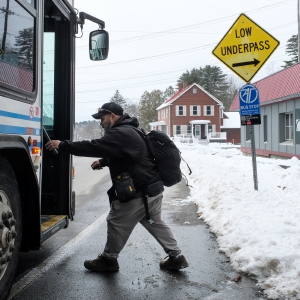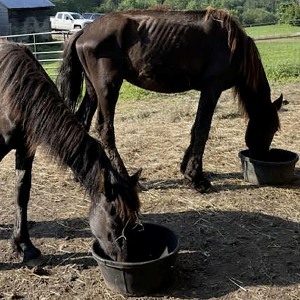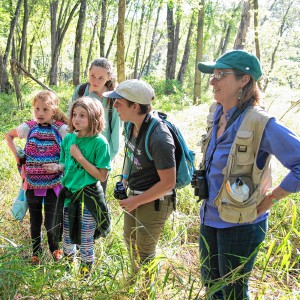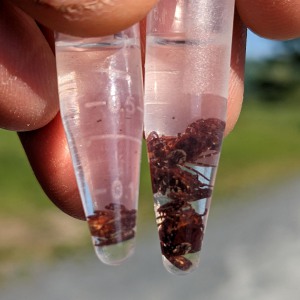Orford Tree Farm Cultivates Lupines
| Published: 06-21-2016 10:00 PM |
Orford
“A lot of people in the last week have been calling,” Thomson said last Thursday, during a ramble through his network of woodlands, meadows, beaver ponds and bogs between Mount Cube and Smarts Mountain. “ ‘Are you going to open the gates?’ ”
He is and he has been doing so for friends, neighbors, family, school groups and Scout troops for the better part of 10 years, since word got around about the corridors of lupines that bloom every June in clearings through the 1,060 acres he bought from International Paper in 1989.
“I seeded the lupines in not to have a lupine tour, but because they would put down a long taproot to hold the soil,” Thomson said. “The goal was to protect against soil erosion, and it’s done it well.”
And the lupines, clamoring for attention amid grasses, paintbrush, Queen Anne’s lace and other vegetation, as well as looping butterflies, have given Thomson another platform through which to share the evolving ecosystem around the headwaters of Jacobs Brook, along both sides of the former highway between Orford and Wentworth that forms the backbone of the Thomson Family Tree Farm’s network of roads.
“This is a unique piece of land, with a lot of diversity,” said Thomson, one of six children of the late New Hampshire Gov. Meldrim Thomson and his wife Anne. “Along with the trees, a lot of water bogs and ponds and ledges. I fell in love with it.”
The taproot of that attachment deepened when his grandson Jaden Thomson started following his grandfather on his rounds, learning about managing the woods, as well as about the deer and bear and moose and beaver and turkey that had moved in, along with lupines and small patches of lady’s slippers, after the timber harvest created openings in the forest.
“I’m not sure,” the 12-year-old son of Tom and Sheila Thomson’s son Stacey said of how long ago he joined his grandfather. “I was young.”
Article continues after...
Yesterday's Most Read Articles
 Upper Valley winter shelters kept dozens warm and dry
Upper Valley winter shelters kept dozens warm and dry
 Former principal of South Royalton School released from prison
Former principal of South Royalton School released from prison
 Owner of Friesian horse facility ordered to pay care costs for seized animals
Owner of Friesian horse facility ordered to pay care costs for seized animals
He’s old enough now to carve short trails from the main road out to vistas where Tom Thomson has placed picnic tables for visitors. Lately Jaden also been cutting hemlock logs that he fashions into benches — each with two stump-sized cylinders for the base and one split-and-sanded log for the seat — at lookouts and at ponds where visitors can watch the wildlife.
Right about this age, Stacey “helped with the trails, and worked hard,” Tom Thomson recalled, adding that Stacey started a firewood business and went on to form his Thomson Timber Harvesting and Trucking company.
Now in his early 70s, Tom Thomson figures he also was 11 or 12 when he joined brothers David and Peter in buying a 125-acre woodlot for $235, the first of several they gradually bought in the vicinity of their father’s Mount Cube Farm.
The brothers maintained the land while pursuing day jobs — in Tom’s case, after a post-high-school stint in the National Guard, working in publishing. In the mid-1970s he joined his brother Robb in running the family’s law book company, Equity Publishing, during their father’s three terms as governor, and stayed on until the sale of the company in 1989.
And then Thomson dove full-time into managing and expanding the tree farm, advocating for sustainable forestry and sharing what he’s learned with others.
With groups of kids, Thomson passes around cookie-shaped pieces of wood that show the growth rings and the bark of the different varieties.
“Once I had a youngster ask, ‘Mr. Thomson? Did you cut a tree to make these wood cookies?’” Thomson recalled. “I said, ‘Yes,’ and she asked, ‘You killed a tree?’ And I thought, ‘This is going to be a good class.’ ”
Thomson’s own education continues every year, particularly as the tree farm evolves.
“I don’t remember any lupines being here,” he said. “I wasn’t aware of the potential until I got this land, and we were putting in the road system, and we were more attuned to preventing erosion.”
The lupines have spread far and widely enough that, after the 2015 crop finished blooming, Thomson filled 40 five-gallon buckets with seeds he’d stripped straight from the stalks. At the end of every season he spreads the seeds on a tarp in his barn to dry.
“I give away a lot to people who are interested, and the rest we put in places where we’ve disturbed the soil,” Thomson said. “You don’t just pop them in the ground. You have to do a little work. I apply some pelletized lime to offset the acid in the soil.
“After that, they pretty much take care of themselves.”
And they give Thomson yet another reason to keep venturing out here, with two artificial knees and two new hips, to see and share what’s new.
“As long as I can move, I’m going to be working,” Thomson said. “That keeps you going, day after day.
“It’s a labor of love.”
To arrange group tours of the Thomson Family Tree Farm and Wildlife Habitat, call 603-353-4488.
David Corriveau can be reached at dcorriveau@vnews.com and at 603-727-3304.

 JAG Productions announces closure, citing ‘crisis facing the arts’
JAG Productions announces closure, citing ‘crisis facing the arts’ How a hurricane and a cardinal launched a UVM professor on a new career path
How a hurricane and a cardinal launched a UVM professor on a new career path Out & About: Vermont Center for Ecostudies continues Backyard Tick Project
Out & About: Vermont Center for Ecostudies continues Backyard Tick Project
